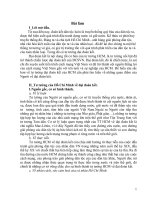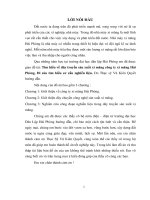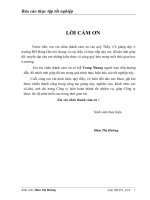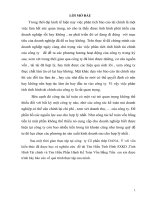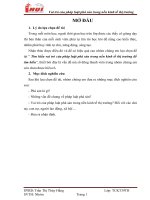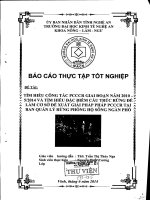Tìm hiểu về việc ứng dụng chuẩn ISO/IEC 9126 vào đánh giá chất lượng các hệ thống thương mại điện tử
Bạn đang xem bản rút gọn của tài liệu. Xem và tải ngay bản đầy đủ của tài liệu tại đây (294.13 KB, 58 trang )
VIETNAM NATIONAL UNIVERSITY, HANOI
UNIVERSITY OF LANGUAGES AND INTERNATIONAL STUDIES
DEPARTMENT OF POST-GRADUATE STUDIES
BÙI THỊ ÁNH TUYẾT
M.A. MINOR THESIS
CLASSROOM ACTIVITIES TO STIMULATE 10-FORM STUDENTS’
PRESENTATION IN ENGLISH SPEAKING LESSONS AT MARIE
CURIE HIGH SCHOOL, HAI PHONG
(Các hoạt động trong lớp học để khuyến khích khả năng trình bày tiếng Anh
của học sinh lớp 10 trường THPT Marie Curie, Hải Phòng)
Field: English teaching methodology
Code:
60 14 10
Cohort:
MA 15
Supervisor: Lê Thế Nghiệp, M.A
Hanoi, 2009
TABLE OF CONTENTS
ABSTRACT.................................................................................................................................i
ACKNOWLEDGEMENTS.......................................................................................................ii
ABBREVIATIONS...................................................................................................................iii
INTRODUCTION......................................................................................................................1
1. RATIONALE......................................................................................................................1
2. OBJECTS OF STUDY.......................................................................................................2
3. AIMS OF STUDY.............................................................................................................2
4. SCOPE OF STUDY..........................................................................................................2
5. METHODOLOGY OF STUDY.........................................................................................3
6. RESEARCH HYPOTHESES.............................................................................................3
7. DESIGN OF THE STUDY................................................................................................3
PART II: DEVELOPMENT.......................................................................................................5
CHAPTER I: LITERATURE REVIEW....................................................................................5
1.1. SOME DEFINITIONS....................................................................................................5
1.2. FACTORS PREVENT STUDENTS FROM PRESENTING A TOPIC........................5
1.2.1. Factors of Foreign Language Anxiety......................................................................5
1.2.2. Factors associated with Learner’s own sense of ‘self’ and ‘language classroom
environment’.......................................................................................................................8
1.2.3. Classroom procedure..............................................................................................10
1.3. Socio-cultural factors.....................................................................................................11
1.3.1. Social environment for L2/FL acquisition.............................................................11
1.3.2. Errors in social setting............................................................................................12
1.4. COMMUNICATIVE CLASSROOM ACTIVITIES....................................................12
1.4.1. Purpose...................................................................................................................12
1.4.2. Requirements..........................................................................................................13
1.4.3. Types of communicative classroom activities.......................................................14
1.5. INTEGRATING SKILLS AND PRESENTATION....................................................16
1.5.1. Important of integrating skills................................................................................16
1.5.2. Presentation through reading activities..................................................................17
1.5.3. Presentation through writing activities..................................................................17
1.5.4. Presentation through listening activities................................................................17
CHAPTER II.............................................................................................................................19
THE STUDY.............................................................................................................................19
2.1. Aims...............................................................................................................................19
2.2. Informants......................................................................................................................19
2.3. Hypotheses: Remarks on some problems of English learning and teaching at Marie
Curie High school, Hai Phong city.......................................................................................19
2. 3.1. Materials................................................................................................................19
2.3.2. Teachers’ method...................................................................................................20
2.3.3. Students’ motivation...............................................................................................20
2.4. Methods..........................................................................................................................21
2.5. Data collection ..............................................................................................................22
2.6. Data analysis .................................................................................................................22
2.6.1. Survey questionnaire for teachers .........................................................................22
2.6.2. Survey questionnaire for students..........................................................................25
2.7. Discussion of the findings.............................................................................................27
CHAPTER III:..........................................................................................................................29
3.1. Information sources.......................................................................................................29
3.2. Activities in class...........................................................................................................30
3.3. Practical tips for teachers...............................................................................................39
PART III ...................................................................................................................................42
CONCLUSION.........................................................................................................................42
1. Summary of the study.......................................................................................................42
2. Limitations of the study....................................................................................................43
3. Suggestions for further study............................................................................................43
REFERENCES.........................................................................................................................44
APPENDIX 1...............................................................................................................................I
APPENDIX 2............................................................................................................................III
APPENDIX 3.............................................................................................................................V
i
ABSTRACT
This thesis is concerned with stimulating 10-form students’ presentation in English speaking
classroom. Specifically, a survey will be taken on teachers of English and 10-form students
at Marie Curie High school in Hai Phong city to consider how English speaking lessons are
conducted and how students respond to English speaking lessons. The thesis also study
students’ difficulties when participating in English speaking lessons. This thesis also
recommends some practical tips and typical classroom activities which were applied by the
author and suggested by teachers of English at Marie Curie High school to improve quality
of teaching and learning presentation in English.
ii
ACKNOWLEDGEMENTS
I would like to express my gratitude to my supervisor, Mr. Le The Nghiep for his guidance
and inspiration while I was working on this study.
Research for this paper was supported by the Post-graduate Department - College of
Foreign Languages – Hanoi National University with encouragements and permissions.
I would also like to acknowledge the advice, comments I have received from my colleagues
at Marie Curie High school in Haiphong.
My thanks also go to 10 teachers and 100 students at Marie Curie High school in Haiphong
who provided me with valuable data for the study so that I can have a better view of
activities in presentation task in English speaking classes at Marie Curie High school in
Haiphong.
Finally, I would like to thank my family for their special care and support.
iii
ABBREVIATIONS
CA:
Communication Apprehension
CLT: Communicative Language Teaching
EFL: English as Foreign Language
ELT: English Language Teaching
ESL: English as Second Language
FL:
Foreign Language
L1:
First Language
L2:
Second Language
1
PART I
INTRODUCTION
1. RATIONALE
As English has been an international language, the ability to present a topic is clearly
valuable at every stage of students’ lives. Whatever the subjects they study, presentation will
bring them success in English speaking classes, academic work, job interviews and their
future work life – it is the most transferable of all their skills, and a critical part of their
professional development. Presentation is also an important part in an English speaking class
at high school, in which students are required to present their ideas in a short and simple
way.
This research is motivated by both subjective and objective reasons. Subjectively, doing a
research on Methodology, especially on teaching speaking is very useful for a teacher of
English. Objectively, the importance of English in communication is increasingly
emphasized, while the present English teaching at Vietnam’s high schools seems to face with
an
obstacle
in
improving
learners’
communicative
competence.
According
to
Communicative Language Teaching (CLT), the purpose of language teaching and learning is
to develop communicative competence in the target language. Littlewood also states: “One
of the most characteristic features of Communicative Language Teaching is that it pays
systematic attention to functional as well as structural aspects of language”. However, the
traditional method applied at Vietnamese secondary schools does not comply with the
textbook at all. Most teachers focus on teaching vocabulary, grammar, reading and writing
skills. They do not pay adequate attention to speaking and listening skills. As a result, this
leads to some problems. Learners can be good at written English but they have difficulty in
using it in oral communication. Besides, their English is not good enough to use in real
communicating situations. Moreover, teaching and learning conditions at Vietnamese
secondary schools are face with some drawbacks. A class of 45 to 50 learners is not
appropriate for language teaching and learning. Therefore, a suggested solution is that
2
teachers should apply suitable classroom activities to stimulate learners’ speaking ability
right from the beginning.
Hopefully, this study will make a small contribution to the application of communicative
language teaching approach in developing the 10th form learners’ ability in presentation at
Vietnamese secondary schools in general and at Marie Curie high school in Haiphong in
particular.
2. OBJECTS OF STUDY
Due to actual English teaching and learning conditions, so far the most widely used English
textbooks at Vietnamese high schools have been applied to 7-year English course. Thus, the
subjects of the study will be the high school students who use 7-year English textbooks. For
the limitation of the study, it can only focus on the 10th form Marie Curie high school
students.
3. AIMS OF STUDY
Fist of all, this study is conducted to emphasize the importance of presentation skill in
learning English.
Secondly, this study will suggest some classroom activities to stimulate the 10 th form Marie
Curie High school students in presentation tasks in an English speaking class.
Finally, it provides suggestions for teachers of English to prepare English lessons at Marie
Curie High school.
4. SCOPE OF STUDY
Due to the limit of the thesis, the study can not cover all techniques to stimulate students’
speaking ability in a language class. Therefore, it will focus on some typical classroom
activities which may produce a stimulus for the 10 th form Marie Curie High school students’
presentation.
3
5. METHODOLOGY OF STUDY
The theoretical background of the study is mainly based on the books and documents written
by a number of scholars on foreign language teaching.
This study is conducted based on qualitative and quantitative methods. Comments, remarks,
suggestions and conclusions are based on actual researches, experience, and discussions.
Besides, books are used as reference.
Situational survey will be conducted on the students’ learning style and motivation, their
problems in English presentation tasks. The study will also be conducted on teachers’
techniques to raise students’ ability of presentation.
Questionnaires will be given to analyze learners’ attitude towards presentation tasks as well
as teachers’ techniques in speaking classes and needs in foreign language teaching and
learning.
6. RESEARCH HYPOTHESES
Perhaps one of the obvious problems is the lack of students’ interest and active participation
in learning activities. Traditional methods of teaching in English classrooms have focused on
passive learning. This problem is probably caused by less exciting and practical activities of
teachers. The questions to be dealt with are:
How important is presentation to foreign language learning?
What should be done to stimulate the 10 th form Marie Curie High school students in
presentation tasks in an English speaking class?
7. DESIGN OF THE STUDY
The study is intended to consist of three parts:
1. Part 1 – Introduction: give reasons for choosing the thesis, objects, aims and scope of
the study as well as the methodology of the study.
2. Part 2 – Development: will be divided into three chapters:
4
Chapter 1: Literature Review focus on some definitions of presentation, types of
presentation. Some factors that prevent students from presenting a topic and communicative
classroom activities are also mentioned as the basis of the thesis. Finally, the thesis discuss
the important of integrating skills, the relation between presentation and other skills
including reading, writing and listening.
Chapter 2: The study gives the data analysis from the survey of 10 teachers of
English and 100 students at Marie Curie High school to make the foundation for the
activities in chapter 3.
Chapter 3: indicates some typical activities and practical tips for teacher to stimulate
10-form students’ presentation in an English speaking lesson and examples for illustration.
3. Part 3 – Conclusion: summarizes the study, limitations of the study and suggestions
for further study.
5
PART II: DEVELOPMENT
CHAPTER I: LITERATURE REVIEW
1.1. SOME DEFINITIONS
Presentation is generally defined in different dictionaries is to show and to explain the
content of a topic to an audience or to audiences. According to Wikipedia – The Free
Encyclopedia, presentation is the process of showing and explaining the content of a topic to
an audience. The same definition is also recognized by Longman Language Activator (1998:
1017) – To present is to be the person who tells the people watching or listening about the
different things what will happen or are happening.
For 10-form students, presentation is simplified and limited in a given topic. In a typical 10form English speaking lesson, students are asked to make small presentations based on a
given topic. The lesson is normally built up with three tasks:
-
Task 1: Students practice sample dialogues to have a general understanding about the
topic;
-
Task 2: Students participate in group discussion, in which students express their
ideas and get to know the others’ ideas on the given topic.
-
Task 3: From the ideas collected from discussion task, students integrate the ideas to
make a presentation. This presentation will be presented by a student on behalf of
his/her group.
1.2. FACTORS PREVENT STUDENTS FROM PRESENTING A TOPIC
1.2.1. Factors of Foreign Language Anxiety
Anxiety has been found to interfere with many types of learning but when it is associated
with learning a second or foreign language, it is termed as ‘second/foreign language
anxiety’. It is a complex and multidimensional phenomenon (Young, 1991) and can be
defined as a subjective feeling of tension, apprehension, nervousness, and worry associated
6
with an arousal of the automatic nervous system. Is has been found that the feeling of tension
and nervousness center on two basic task requirement of foreign language learning: listening
and speaking because both the skills can not be separated.
According to Horwitz et al. (1986: 127), there are three related performance anxieties: (1)
communication apprehension (CA); (2) test anxiety; (3) fear of negative evaluation. Due to
its emphasis on interaction, the construct of communication apprehension is also relevant to
the conceptualization of foreign language anxiety (McCroskey, 1977). The description of
these components will lay the foundations for the concept of second/foreign language
anxiety, providing an insight to comprehend the sources or causes it can originate from.
•
Communicative Apprehension (CA)
The speaking skill is so central to our thinking about language learning that when we refer to
speaking a language we often mean knowing a language. MacIntyre and Garder (1991)
points out that the skill which produces most anxiety is speaking. This anxiety comes in part
from a lack of confidence in our general linguistic knowledge but if only this factor were
involved, all skills would be affected equally. What distinguishes speaking is the public
nature of the skill, the embarrassment suffered from exposing our language imperfections in
front of others.
One of the most studied topics in the field of speech communication is the tendency on the
part of some people to avoid, and even, fear, communicating orally. Horwitz et al. (1986:
128) define communication apprehension (CA) as “a type of shyness characterized by fear or
anxiety about communicating with people”.
Communication anxiety may be specific to just a few settings (e.g., public speaking) or may
exist in most everyday communication situations, or may even be part of a general anxiety
trait that arises in many facets of an individual’s life (Fiedman, 1980). Learners’ personality
traits such as shyness, quietness, and reticence are considered to frequently precipitate CA.
These feelings of shyness vary greatly from individual to individual, and from situation to
situation. McCroskey and Bond (1980) found seven factors that could result in a quiet child
(this can equally offer explanation of adult CA); (1) low intellectual skills, (2) speech skill
deficiencies, (3) voluntary social introversion, (4) social alienation, (5) communication
7
anxiety, (6) low social self-esteem, (7) ethnic/cultural divergence in communication norms.
While communication apprehension is one of these factors, the others can lead to
communication apprehension.
Communication apprehension obviously plays a large role in second/foreign language
anxiety. People who are apprehensive speaking groups are likely to be ever in more trouble
when doing so in a second/foreign language class, where in addition to feeling less in control
of the communicative situation, they also may feel that their attempts at oral work are
constantly being monitored. This apprehension is explained in relation to the learner’s
negative self-perceptions caused by the inability to understand others and make himself
understood. McCroskey (in Apaibanditkul, 2006: 4) labels this kind of apprehension – which
Neer refers to as “apprehension about classroom participation” – as classroom
communication apprehension.
•
Test anxiety
An understanding of test anxiety is also important to the discussion of foreign language
anxiety. Text anxiety, as explained by Horwitz et al. (1986), refers to a type of anxiety
stemming from a fear of failure. Test anxiety is quite common in language classroom at any
levels.
Unfortunately, for highly anxious students, second/foreign languages, more than any other
academic subject, require continual evaluation by the teacher – the only fluent speaker in the
class. It is also important to note that oral testing has the potential to provoke both test and
oral communication anxiety.
•
Fear of Negative Evaluation
Fear of negative evaluation is an extension of the second component (test anxiety) of
second/foreign language anxiety because it is not limited to test-taking situations; rather, it
may occur in any social, evaluative situation, such as interviewing for a job or speaking in
second/foreign language class. It is also broader in the sense that it pertains not only to the
teacher’s evaluation of the students but also to the perceived reaction of other students as
8
well. Besides, students, when making presentations, may be anxious due to their in sufficient
background knowledge on the topic discussed.
In spite communication apprehension, test anxiety, and fear of negative evaluation provide
useful conceptual building blocks for a description of second/foreign language anxiety, it is
more than just the conglomeration of these three components. We conceive foreign language
anxiety as a distinct complex of self-perception, beliefs, feelings, and behaviors related to
classroom language learning arising from the uniqueness of the language learning process.
What makes language learning a distinct and unique process is its interaction with the
concept of ‘self’.
1.2.2. Factors associated with Learner’s own sense of ‘self’ and ‘language classroom
environment’
As mentioned above, the language anxiety is related to three components. All the three
components are strongly linked with learners’ sense of ‘self’, as it is learners’ ‘self’ which is
at risk of failure or being negatively evaluated in any test-like situation or a situation which
requires communication in front of others. This risk to one’s sense of ‘self’ frequently occurs
in a L2/FL classroom. This section reviews literature on language anxiety related to learners’
sense of ‘self’ and ‘language classroom environment’.
•
Self perceptions
According to Horwitz et al. (1986: 128), perhaps no other field of study poses as much of a
threat to self-concept as language study does. They believe that any performance in L2 in
likely to challenge an individual’s self-concept as a competent communicator, which may
lead to embarrassment. Laine (1987: 15) indicates that self-concept is the totality of an
individual’s thoughts, perceptions, beliefs, attitudes and values having reference to himself
as object. This self-concept forms the basis of the distinction between language anxiety and
other forms of academic anxieties. The importance of the disparity between the ‘true’ or
‘actual’ self as known to the language learner and the more limited self as can be presented
at any given moment in the foreign language would seem to distinguish foreign language
anxiety from other academic anxieties such as those associated with mathematics or science.
9
•
Learners’ belief about language learning
As language learning poses a threat to learners’ self-concept, in response learners may
generate some particular beliefs about language learning and its use. Certain beliefs about
language learning also contribute to the student’s tension and frustration in the class. For
example, the followings are such reported beliefs:
“I just know I have some kind of disability: I can’t learn a foreign language no matter how
hard I try.” (Horwitz et al. 1986: 123).
“Russian is too hard. I’ll never be able to learn Russian enough to go to Russia and talk to
people”. (Tittle, 1997: 15)
Such beliefs have been found to cast a considerable influence upon the ultimate achievement
and performance in the target language. In Ohata (2005: 138), a number of beliefs derived
from learner’s irrational and unrealistic conceptions about language learning, such as
1) Some students believe that accuracy must be sought before saying anything in the foreign
language,
2) Some attach great importance to speaking with excellent native (L1)-like accent,
3) Others believe that it is not ok to guess an unfamiliar second/foreign language word,
4) Some hold that language learning is basically an act of translating from English or any
second/foreign language,
5) Some view that two years are sufficient in order to gain fluency in the target language,
6) Some believe that language learning is a special gift not possessed by all.
These unrealistic perceptions or beliefs on language learning and achievement can lead to
frustration or anger towards students’ own poor performance in a second/foreign language.
10
•
Instructors’ beliefs about language teaching
Just like learners’ beliefs about language learning, some instructor’s beliefs about language
learning and teaching have also been found to be a source of anxiety. Onwuegbuzie (1999:
220) asserted instructors’ belief that their role is to correct rather than to facilitate students
when they make mistakes. Further, he stated that the majority of instructors considered their
role to be less a counselor and friend and objected to a too friendly and inauthoritative
student-teacher relationship. The researcher also reported that students realize that some
error corrections are necessary but they consistently report anxiety over responding
incorrectly and looking or sounding ‘dumb’ or ‘inept’. Young (1991: 429) mentioned the
view that the problem for the student is not necessarily error correction but the manner of
error correction – when, how often, and most importantly, how errors are corrected.
In addition to error correction, some instructors have been reported not to promote pair or
group work in fear that the class may get out of control, and think that a teacher should be
doing most of the talking and teaching, and that their role is more like a drill sergeant’s than
a facilitator’s. These beliefs have been found to contribute to learner’s language anxiety
(Young, 1991: 428). Recognition or awareness of these beliefs by both the learners, as well
as the teachers, is essential for effective reduce of language anxiety in learners.
1.2.3. Classroom procedure
Giving a short talk or presentation in the class has also been reported to be highly anxiety
inducing, which makes the classroom environment more formal and stressful for the
learners. Different activities in the classroom procedure, particularly those that demand
students to speak in front of the whole class, have been found to be the most anxiety
provoking. For instance, Koch and Terrell (1991) found that more than half of their subjects
in their Natural Approach classes – a language teaching method specifically designed to
reduce learner’s anxiety – expressed that giving a presentation in the class, oral skits and
discussions in large groups are the most anxiety-producing activities. They also found that
students get more anxious when called upon to respond individually, rather than if they are
given choice to respond voluntarily. In addition, students were found to be more relaxed
speaking the target language when paired with a classmate or put into small groups of three
11
to six than into larger groups of seven to fifteen students. Similarly, Young (1991: 429)
added that more than sixty-eight percent of her subjects reported feeling more comfortable
when they did not have to get in front of the class to speak. Earlier, Horwitz et al. (1986:
123) reported the same:
“Sometimes when I speak English in class, I am so afraid I feel like hiding behind my chair.
When I am in my Spanish class I just freeze! I can’t think of any thing when my teacher calls
on me. My mind goes blank.”
This suggests that any measure to treat language anxiety should not fail to exploit learning
environments where students feel free of anxiety. For this, Communicative Language
Teaching (CLT) approaches are often recommended by the researchers to provide such and
unthreatening environment where students talk to one another and not exclusively to the
teacher.
1.3. Socio-cultural factors
In the previous parts, it has been viewed that difficulties in learning L2/FL can explain the
potential causes of language anxiety at the output stage of language learning within the
classroom setting. However, language anxiety may also be an outcome of social and
communicative aspects of language learning. The following parts will review the literature
on language anxiety from a socio-cultural perspective of language learning and its use.
1.3.1. Social environment for L2/FL acquisition
Environment, where the target language is not used as L1 in the community, provides L2/FL
learners only limited and sometimes faulty input. For such learners, the only input is
teachers’ or classmates’ talk – both do not speak L2 well. Learners in such environments are
exposed to the language only in the classroom where they spend less time in contact with the
language. The limited exposure to the target language and lack of opportunities to practice
speaking in such environments result into embarrassment or stress for them when they are
required to speak both in and out of the class.
12
1.3.2. Errors in social setting
Although it is clear that language learning cannot be without errors, errors can be a source of
anxiety in some individuals because they draw attention to the difficulty of making positive
social impressions when speaking a new language (MacIntyre & Gardner, 1989: cited in
Horwitz & Gregersen, 2002: 562). Errors in social settings are mostly overlooked if they do
not interfere with meaning because people consider it impolite to interrupt and correct
somebody who is trying to have a conversation with them. Interlocutors only react to an
error if they cannot understand the speech and try to adjust their speech with the speaker in
their effort to negotiate for meaning. It is only in the classroom environment that feedback
on errors is provided frequently; this leads many learners to frustration and embarrassment
by making them conscious of their deficiencies.
1.4. COMMUNICATIVE CLASSROOM ACTIVITIES
1.4.1. Purpose
Communicative activities are those which exhibit the characteristics at the communicative
end of our continuum. Learners are somehow involved in activities that give them both the
desire to communicate and a purpose which involves them in a varied use of the target
language. Such activities are vital in a language class since the learners can do their best to
use the language as individuals, arriving at a degree of language autonomy. Littlewood
(1981) favored the opinion that it is quite necessary to consider the following purposes of
communicative activities:
•
They provide ‘whole-task practice’. In foreign language learning, our means for
providing learners with whole-task practice in the classroom is through various kinds
of communicative activities, structured in order to suit the learners’ level of ability.
•
They improve motivation. The learners’ ultimate objective is to take part in
communication with others. Their motivation to learn is to be sustained if they can
see how their classroom learning is related to this objective and helps them to
achieve it with increasing success.
13
•
They allow natural learning. Languages takes place inside the learners and, as
teachers know to their frustration, many aspects of it are beyond their pedagogical
control. It is likely, in fact, that many aspects of language can take place only through
natural processes, which operate when a person is involved in using the language for
communication. If this is so, communicative activity (inside or outside the
classroom) is an important part of the total learning process.
•
They can create a context which supports learning. Communicative activity
provides opportunities for positive personal relationship to develop among learners
and between learners and teacher. These relationships can help to ‘humanize’ the
classroom, and to create an environment that supports the individual in his effort to
learn. Oral communicative activities apply the same purposes, as communicative
activities are operated mainly through oral communication.
1.4.2. Requirements
In order to get involved in activities in an English speaking class, teachers of English should
pay attention to the following requirements (Ur, 1996: 120):
•
Learners talk a lot. As much as possible of the period of time allotted to the activity
is in fact occupied by learner talk. This may seem obvious, but often most time is
taken up with teacher talk or pauses.
•
Participation is even. Classroom discussion is not dominated by a minority of
talkative participants: all get a chance to speak, and contributions are evenly
distributed.
•
Motivation is high. Learners are eager to speak: because they are interested in the
topic and have something new to say about it, or because they want to contribute to
achieving a task objective.
•
Language is of an acceptable level. Learners express themselves in utterances that
are relevant, easily comprehensible to each other, and of an acceptable level of
language accuracy.
14
1.4.3. Types of communicative classroom activities
Because communicative principles can be applied to the teaching of any skill, at any level, and
because of the wide variety of classroom activities and exercise types, description of typical
classroom procedures used in a lesson based on CLT principles is not feasible. However, most
practitioners of CLT accept the general procedure with the following communicative activities in
their materials and language class provided by Littlewood (1981).
Pre-communicative activities:
Structural activities
Quasi-communicative activities
Communicative activities:
Functional communication activities
Social interaction activities
•
Pre-communicative activities
These activities are ones to prepare for the communicative activities which learners are
required to do.
In pre-communicative activities, the teacher isolates specific elements of knowledge and
skills which compose communicative ability, and provide the learners with opportunities to
practice them separately. This first kind of activities is sub-divided into structural activities
and quasi-communicative activities.
•
Structural activities
Structural activities focus on the grammatical system, describing ways in which language
elements can be combined. These activities consist of pronunciation, vocabulary and
structure practice.
•
Quasi- communicative activities
Quasi-communicative activities consist of one or more typical conversational exchanges.
Some resemble drills, but others are closer to dialogues. These quasi-communicative
15
activities are intended to help the learners relate forms and structures to communicative
function, specific meaning, and social context.
In short, the aim of pre-communicative activities is to practice using acceptable language
fluently, without being concerned to communicate meanings effectively.
•
Communicative activities
These activities require the learners to integrate his pre-communicative meanings. In
discussing the various examples of communicative activities, Littlewood proposes to
distinguish between two main categories: functional communication activities and social
interaction activities.
•
Functional communication activities
Functional communication activities are those which emphasize the functional aspect of
communication – the ability to find language which convey in intended meaning effectively in
a specific situation. The main purpose of the activity is that learners should use the language
they know in order to get meanings across as effectively as possible. Success is measured
primarily according to whether they cope with the communicative demands of the immediate
situation. Some examples of these activities are questions and answers, open-ended responses,
interview based on a text, information-gap activities, role-plays, etc.
•
Social interaction activities
Social interaction activities are those which place emphasis on social as well as functional
aspects of communication. Learners must still aim to convey meanings effectively, but must
also pay greater attention to the social context in which the interaction takes place. Success is
now measured not only in terms of functional effectiveness of the language but also in terms
of the acceptability of the forms that are used. In the early stages of learning, acceptability
may mean little more than a reasonable degree of accuracy in pronunciation and grammar.
Later, it will increasingly come to include producing language which is appropriate to
specific kinds of social situation. Examples of these activities are pair/group-work activities
such as simulations, role-plays, and discussions.
16
1.5. INTEGRATING SKILLS AND PRESENTATION
1.5.1. Important of integrating skills
The term “integrated skills” is frequently used as if it was almost synonymous with
reinforcement. Viewed in this way, the process of integrating language skills involves
linking them together in such a way that what has been learnt and practices through the tasks
of one skill is reinforced and perhaps extended through further language activities which
bring one or more of the other skills into use.
Therefore, typically, a piece of spoken language, in the form of a dialogue, will be followed
by relating writing activities. Indeed, this pattern-oral work leading to reading and writinghas almost become the classical model for the organization of learning materials into
“lesson” or “units”. The extent to which this is done and the way in which it is implemented,
in the form of teaching materials will be influenced by such factors as the level of the course,
the relative importance of skills for the learners, and the view taken of the optimum ordering
of the skills, but overall, this kind of skill linking is regarded as pedagogically sound.
This consumption can be supported by the importance of integrated skills activities as
follows (Donn Bryne, 1987)
1. They provide opportunities for using language naturally, not just practicing it.
2. Many pair- and group work activities call for a variety of skills, sometimes
simultaneously in order to involve all the learners.
3. Learners seem to learn better when they are engaged in activities which involve
more than one skill.
We are not of course suggesting that single-skill activities are not effective: there will in fact
be many occasions when we shall ask the learners just to talk or read or write, because this is
appropriate. Equally, however, we should be looking for opportunities to knit together,
because this is what happens in real life.
17
1.5.2. Presentation through reading activities
It is clear that, integrating skills is useful to create or to prepare contexts for practicing and
using the intended language item or skill. In additions, the use of one skill leads quite
naturally to the use of another. As a result, reading is likely to lead to speaking. To give
simple example, if we read an advertisement for a job in the newspaper, we may discuss it
with someone else or ring up and enquire the advertising company about the job.
More specifically, in the classroom, if we are looking for sources of talk, whether guided or
free, it is apparent that many of these come from reading activities. Learners will, of course,
need dialogues as conversational models but these are not necessarily the best stimuli for
talk. A reading text on an interesting or relevant topic may be much more productive, often
because the ideas are presented more directly. Through reading the learners can also greatly
expand their receptive knowledge of the language, especially in the often area of vocabulary.
1.5.3. Presentation through writing activities
Similarly, writing activities are sources of talk. A writing activity, done collaboratively in
pairs or small groups, will be accompanied by a good deal of talk-talk that is needed to “get
something done”. For example, to prepare for a discussion, learners in pairs or groups take
notes of their ideas and arguments. It is the same in problem- solving activities, learners
prefer to note down solutions to speak fluently and logically. There are many other speaking
activities necessarily prepared by writing activities in advance. Generally, the writing
activities before presenting a topic are very beneficial, especially for language students at
elementary level. They can write to arrange ideas and memorize words and expressions as
well, which will help them to speak more easily and confidently.
1.5.4. Presentation through listening activities
Like reading and writing activities, listening activities do create a stimulus for speaking
activities. For example, students hear a short conversation (or an extract from a long
conversation), which provides very few clues as to what the speakers are talking about. The
learners themselves have to decide who the speakers are, where they are, what they are
talking about and possibly what will happen next. This type of listening then, leads on
18
naturally to discussion. In another listening activity, learners are given some information, for
example about a town (places of interest, facilities, etc.) in the form of a talk or conversation,
on the basis of which they have to plan a visit. The planning involves discussion and
decision-making activities; making choices between places, events; activities for which the
background information is made available in the recorded form.
However, oral communicative activities through listening comprehension require learners to
have a comparatively good listening ability so that learners can catch information and ideas
for speaking activities afterwards. Therefore, it is necessary for learners to do simple
listening activities right from the beginning of the course and then they can gradually do oral
communicative activities effectively based on listening comprehension.

